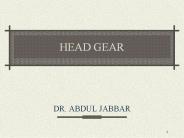Maxilla PowerPoint PPT Presentations
All Time
Recommended
Maxilla bone Hamulus Hamulus Hamulus Maxillary tuberosity Maxillary tuberosity Maxillary tuberosity Maxillary sinus/floor of the sinus Maxillary sinus/floor of the ...
| PowerPoint PPT presentation | free to view
Title: Recording Maxillo-mandibular Relationships Author: Loney Last modified by: Anonymous Loney Created Date: 2/23/2001 6:53:12 PM Document presentation format
| PowerPoint PPT presentation | free to view
MRI Scan - Maxilla Test - View Normal Values, Test Results, Procedure to conduct & Best Prices for MRI Scan - Maxilla Test | Lybrate
| PowerPoint PPT presentation | free to download
Patient can assist with placement and orientation in external auditory meatus. Orient in external auditory meatus. Slide facebow onto bitefork ...
| PowerPoint PPT presentation | free to view
Classic tripod, orbital floor, LeFort fractures better thought of as ... 'Rigid' fixation misnomer with small plates and thin bones ...
| PowerPoint PPT presentation | free to view
defect of biosynthesis of collagen I. thin bones without ... hard bony protuberance. coronoid or condylar procces. joint dysfunction. Non-odontogenic tumors ...
| PowerPoint PPT presentation | free to view
ethmoid. ethmoid. ethmoid. zygomatic. zygomatic. zygomatic ... ethmoid. ethmoid. ethmoid. zygomatic. zygomatic. zygomatic. maxilla. maxilla. maxilla. mandible ...
| PowerPoint PPT presentation | free to view
MRI Scan - Maxilla Test - View Normal Values, Test Results, Procedure to conduct & Best Prices for MRI Scan - Maxilla Test | Lybrate
| PowerPoint PPT presentation | free to download
Dental Implants PEEK Temporary Abutments are intended to be used in the Maxilla or Mandible for supporting a temporary prosthesis on endosseous implants in order to restore chewing function for the patient.
| PowerPoint PPT presentation | free to download
Occlusal radiography Terminology and classification I.Maxillary occlusal projections Upper standard occlusal (standard occlusal) Upper oblique occlusal (oblique ...
| PowerPoint PPT presentation | free to download
Chapter 13 Facial Bones Part 1 Facial Bones 14 Bones 2 Maxillae 2 Zygomatic 2 Lacrimal 2 Nasal 2 Inferior nasal conchae 2 Palatine 1 Vomer 1 Mandible Maxillary ...
| PowerPoint PPT presentation | free to view
IN COMPLETE DENTURE 7. ... - In the maxillae, the horizontal portion of the hard palate lateral to the midline raphe should provide support for complete dentures.
| PowerPoint PPT presentation | free to download
Operative complications. inadvertent placement of implant into sinus or submandibular space ... Operative: Jaw (maxilla), use of reconstructive procedures ...
| PowerPoint PPT presentation | free to view
Odontogenic cysts and neoplasms Adenomatoid Odontogenic Tumor Enamel organ or dental lamina origin Young patients, females males, anterior maxilla and mandible ...
| PowerPoint PPT presentation | free to view
Clinical Pathological Conference---Compound Odontoma. Wu Cheng ... Compound---incisor-canine area of the maxilla; Complex-- 1st and 2nd molar of the mandible ...
| PowerPoint PPT presentation | free to view
Head. Wing. Abdomen. Mandible. Antenna. Compound Eye. Leg. Thorax. Maxilla. Blue Striped Benjamin Bug. Designed By Johnny ...
| PowerPoint PPT presentation | free to download
Facial Skeleton Maxillae (2) Form the upper jaw Portions comprise the anterior (???) roof of the mouth ( hard palate ), the floors of the orbits (???), and the ...
| PowerPoint PPT presentation | free to download
Independent Contributions of Airway Skeletal Dimensions and Obesity to Sleep Apnea ... Maxillary Dimension Increases the Odds of Moderate/Severe Sleep Apnea by: ...
| PowerPoint PPT presentation | free to view
* * Alveolar bone is defined as the bony portion of the maxilla and the mandible in which roots of the teeth are held by fibers of periodontal ligament .
| PowerPoint PPT presentation | free to download
often has spines or teeth (denticles) -- grinding (gizzard-like function) ... silk secretion (spinnerets: labium, hypopharynx, maxilla) The Insect Digestive System ...
| PowerPoint PPT presentation | free to view
Head Anatomy. Head Anatomy. Skull. Temporal, Maxilla. Mandible, Occiput. Frontal, Parietal ... 'clinical syndrome characterized by immediate and transient ...
| PowerPoint PPT presentation | free to view
Possess jaw-like appendages called mandibles and maxillae (instead of chelicerae ... http://www.microscopy-uk.org.uk/mag/imagsmall/copepod.jpg. Copepod ...
| PowerPoint PPT presentation | free to view
Contains foramens for the passage of nerves and blood vessels ... Maxilla & Zygoma. Frontal & Orbital Floor. Best View. Lateral Oblique. Waters. Reverse Townes ...
| PowerPoint PPT presentation | free to view
BONES OF THE SKULL. PARIETAL. ETHMOID. OCCIPITAL. FRONTAL. ZYGOMATIC. MAXILLA. SPHENOID. NASAL ... PARIETAL BONE. VOLMER. TURBINATE BONES. NASAL CAVITY ...
| PowerPoint PPT presentation | free to view
Maxillofacial fractures result from either blunt or penetrating trauma. ... Horizontal fracture of the maxilla at the level of the nasal fossa. ...
| PowerPoint PPT presentation | free to view
Right facial swelling over cheek. Extends supraorbital area to maxilla. Increased lacrimation ... Swelling of cheek. Indurated, red, warm. Fever, pain ...
| PowerPoint PPT presentation | free to view
These curves introduced in the construction of complete ... face-bow A-The maxillary face-bow is one generally used in construction of complete denture B-it ...
| PowerPoint PPT presentation | free to view
What tasks does your digestive system do? ... Alveoli in the Maxilla (upper jaw) & Mandible (lower jaw) Closing jaw = masseter. temporalis ...
| PowerPoint PPT presentation | free to view
Dental extraction is a tedious and sturdy task. Ease of working can be achieved with the help of specified extraction forceps kit. The leading extraction forceps kit in the market is API dental instrument. It’s a kit of 12 instruments including forceps for both maxilla and mandible. All these instruments are ISO and CE Certified, rust-free and autoclavable. The best part is sleek, light weighted ergonomics which makes handling easier.
| PowerPoint PPT presentation | free to download
Cancellous bone: marrow bone. Mandible, maxilla. End of long bones in the medullary canal. Epiphysis ... Area between epiphyseal plate to the area where bone ...
| PowerPoint PPT presentation | free to view
Herpetology: the Biology of Tetrapods (BIOEE 470 and 472) ... Increased flexibility of the colubroid palatomaxillary arch freed up the maxilla ...
| PowerPoint PPT presentation | free to view
The surgery used to correct a severe malocclusion from a misaligned jaw is called orthognathic surgery. This includes procedures to move the upper jaw or maxilla forward, backward, or even to widen it. It also includes procedures to move the lower jaw or mandible rotationally to correct asymmetry, forward or backward.
| PowerPoint PPT presentation | free to download
The surgery used to correct a severe malocclusion from a misaligned jaw is called orthognathic surgery. This includes procedures to move the upper jaw or maxilla forward, backward, or even to widen it. It also includes procedures to move the lower jaw or mandible rotationally to correct asymmetry, forward or backward
| PowerPoint PPT presentation | free to download
Muscles of Facial Expression Levator Labii Superioris Origin: Frontal process of maxilla Insertion: Upper lip muscles and nasal cartilage. Action: Elevates upper lip ...
| PowerPoint PPT presentation | free to view
The surgery used to correct a severe malocclusion from a misaligned jaw is called orthognathic surgery. This includes procedures to move the upper jaw or maxilla forward, backward, or even to widen it. It also includes procedures to move the lower jaw or mandible rotationally to correct asymmetry, forward or backward.
| PowerPoint PPT presentation | free to download
The Head and Neck Teeth Gomphosis Synarthrosis Peg in socket with ligament The sockets (alveoli) are in gum-covered margins in mandible and maxilla Periodontal ...
| PowerPoint PPT presentation | free to download
Interim Analysis of Certain PREVAIL Implant Clinical Trial Outcomes ... in both the maxilla and mandible but primarily located inposterior regions (73.5 ...
| PowerPoint PPT presentation | free to view
Fibula. Lower leg bone. Metatarsals. Instep. Phalanges. Toes ... Fibula. Toes (Fingers) Phalanges. Spine or Backbone. Vertebrae. Upper Jaw. Maxilla. Shin bone ...
| PowerPoint PPT presentation | free to view
Maxillary Arch ICD = -1. Mandibular Arch ICD = 1. S. S. S. Bracket set S. Translate posterior teeth distally 0.5mm per side. ICD = 0 to -6. S. Maxillary Arch. ICD ...
| PowerPoint PPT presentation | free to view
Can you see food coloring in front of the crayfish now? ... that a crayfish does not have to use its maxillae or swimmerets to move water ...
| PowerPoint PPT presentation | free to view
Further investigations of source and possible spread ... Samara Seed. Farm D. Germany - Trace Back 3. Dec. 2000 / Jan. 2001. Maxilla Seed. Astarte Seed ...
| PowerPoint PPT presentation | free to view
Vertebrae, hip, & 2 skull bones (sphenoid & the ethmoid bones). Types of Bones ... Ethmoid (1) Sphenoid (1) Facial Bones. Maxilla (2) Zygomatic (2) Mandible (1) ...
| PowerPoint PPT presentation | free to view
Premaxilla and maxilla together form the upper jaw. ... largely external to the bones of the throat, the hyoid and branchial apparatus. ...
| PowerPoint PPT presentation | free to view
Formed by parts of seven bones frontal, sphenoid, zygomatic, maxilla, palatine, ... pedicles and laminae that, along with the centrum, enclose the vertebral foramen ...
| PowerPoint PPT presentation | free to view
REGIO FACEI LATERALIS PROFUNDUS An nisaa Chusida Fossa Infratemporalis Batas-batas : Ventral : tuber maxilla Cranial : facies infratemporalis ala ...
... (Internal) Discolouration likely pulpitis Code D Discolouration Code RD Retained Deciduous Code - Caries Code E Enamel defect Code GH ...
| PowerPoint PPT presentation | free to view
Note systemic conditions that impact on therapy (e.g. angina, hepatitis, ... Retromylohyoid fossa. Need to capture. Especially with severely resorbed ridge ...
| PowerPoint PPT presentation | free to view
Adjustment of Occlusion Rims & VD
| PowerPoint PPT presentation | free to download
Sulcus - a groove - line of strength. Suture - where two sclerites ... in a grasshopper -a dicondylic joint -emphasize strength over mobility. Cardo. Stipes ...
| PowerPoint PPT presentation | free to view
Most venomous snakes have to make direct physical contact with an object ... Phylogeny of snakes remains uncertain, however functional convergence between ...
| PowerPoint PPT presentation | free to download
"Copy Link : gooread.fileunlimited.club/pwjul24/0867158093 Full-Arch Implant Rehabilitation 1st Edition The full-arch implant rehabilitation (FAIR) protocol is one of the newest implant therapy innovations to treat the edentulous or nearly edentulous patient. The FAIR prosthesis is immediate, fixed, esthetically pleasing, highly functional, inexpensive, and maintainable, and it can frequently be installed without bone grafting. This book describes how the FAIR protocol works, who it should be used for, and methods to implement it successfully for different patients. The system can be used in both arches and in patients with total or near-total edentulism. Several chapters are devoted to describing step-by-step treatment with detailed clinical photographs documenting every step from initial assessment to prosthesis delivery. Even those new to fixed denture systems will find the procedures easy to follow and can begin implementing"
| PowerPoint PPT presentation | free to download
HEAD GEAR DR. ABDUL JABBAR * * Duration and magnitude of force Tooth movement Principle : smaller forces for longer duration 100 --- 200 gm / side 14 --- 16 hrs ...
| PowerPoint PPT presentation | free to download
Lecture 4 Skull Objectives: learn the bones of the braincase learn the bones of the face and palate learn the cavities of the skull and associated structures ...
| PowerPoint PPT presentation | free to download
www.nyuseoul.co.kr
| PowerPoint PPT presentation | free to view
Chapter 7: The Skeleton Part A
| PowerPoint PPT presentation | free to download




















































![[PDF] Full-Arch Implant Rehabilitation 1st Edition Full PowerPoint PPT Presentation](https://s3.amazonaws.com/images.powershow.com/10079385.th0.jpg)



